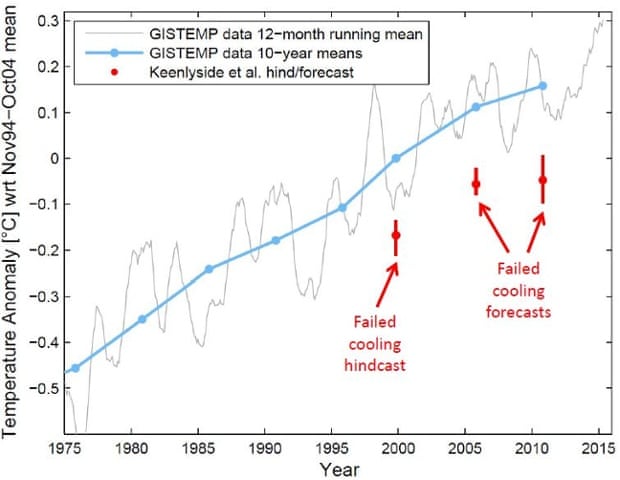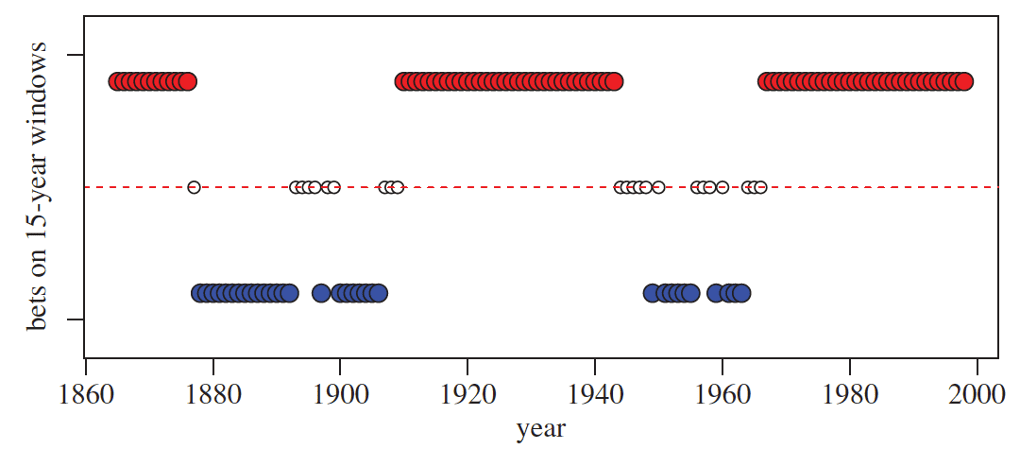
In 2008, a paper was published in the journal Nature predicting that global surface temperatures would cool slightly in the years 2005–2015 as compared to 1994–2004. The authors of that paper thought that during that time, the cool phase of natural ocean cycles would be enough to more than offset warming from the increased greenhouse effect, before human-caused global warming caught up again thereafter. At the time, the paper and its cooling prediction received a tremendous amount of media attention.
There was some truth to the prediction. From about 1999 to 2012, there weremore La Niña than El Niño events, with the former having a short-term cooling influence on global surface temperatures, and the latter having a short-term warming effect. So, it’s true that natural ocean cycles had a temporary cooling effect during that time period.
But, the authors of the paper predicted that global surface temperatures would fall. The climate scientists who blog at RealClimate were so confident that temperatures would continue to rise that they offered the authors a bet.
If the average temperature 2000-2010 (their first forecast) really turns out to be lower or equal to the average temperature 1994-2004, we will pay them € 2500. If it turns out to be warmer, they pay us € 2500. This bet will be decided by the end of 2010. We offer the same for their second forecast: If 2005-2015 turns out to be colder or equal compared to 1994-2004, we will pay them € 2500 – if it turns out to be warmer, they pay us the same.
The authors of the paper declined to accept the bet, which was a good decision, because it turns out they would have lost. Despite the temporary cooling influence of natural ocean cycles and low solar activity since 1999, temperatures have continued to rise due to the strength of the increased greenhouse effect. They have risen more slowly than they would have otherwise, but temperatures have continued to rise nevertheless. As the climate scientists at RealClimatewrote,
It is clear that prediction of global cooling or even stasis was way off the mark, with global warming continuing and observations running more than 0.15ºC warmer than the Keenlyside et al forecast … Had our bet been accepted, it is clear we would have won unambiguously.

Observed global surface temperature data from NASA GISS (gray) and 10-year averages (blue) vs. Keenlyside et al. (2008) cooling predictions. Illustration from RealClimate.org.
One might ask, is it ever again going to be smart to bet against global warming? A paper published earlier this year in the Royal Society journal Philosophical Transactions A asked that very question. The authors looked at the global surface temperature data and considered whether for each 15-year period, a bet of warming or cooling as compared to the previous 15-year average would have won.
The results, shown in the figure below, are strongly influenced by natural climate cycles. Betting on global surface cooling would have usually been a winner in 1880–1910 and 1950–1965. Wagering on global surface warming would have won the bet ever year from 1910 to 1940, and every year since 1970.

Results bets that the 15-year average global surface temperature would increase (red dots), decrease (blue dots) or stay about the same (white dots) from the previous 15-year mean. Figure from Risbey et al. (2015). Source: Philosophical Transactions A.
The authors of the paper note it’s particularly interesting that global warming keeps winning the bet despite ocean cycles, solar activity, and human aerosol pollution all acting in the cooling direction over the past 15 years. Human-caused global warming has become so strong that it’s consistently overcoming these natural short-term cooling factors.
The shift in odds to favour warming changes reflects the growing greenhouse contribution to 15-year trends. The greenhouse contribution is now about the same magnitude as typical naturally occurring 15-year trends … While it is still possible to get negative 15-year changes that will rely on large amplitude and less frequent natural triggers of 15-year changes such as large volcanoes or large amplitude negative [ocean cycle] events.
In other words, betting against global warming is an almost sure way to lose money at this point. As I document in my book Climatology versus Pseudoscience, contrarians rarely predict global temperature changes, but those who do usually predict cooling, and their predictions have performed terribly. Much worse than global warming projections from mainstream climate models.
Posted by dana1981 on Tuesday, 8 December, 2015
 |
The Skeptical Science website by Skeptical Science is licensed under a Creative Commons Attribution 3.0 Unported License. |